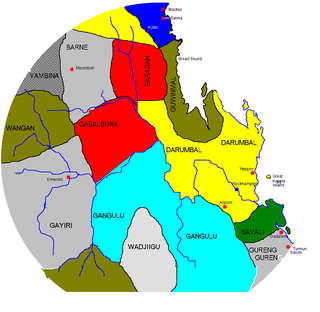Ngardi, also spelt Ngarti or Ngardilj, is an Australian Aboriginal language that is considered moribund. It was previously thought to be an alternative name for the Bunara language, but these are now classified as separate languages. It was/is spoken by the Ngarti people of the Northern Territory and northern Western Australia.
Warluwarra is an extinct Australian Aboriginal language of Queensland. Waluwarra has a traditional language region in the local government area of Shire of Boulia, including Walgra Station and Wolga, from Roxborough Downs north to Carandotta Station and Urandangi on the Georgina River, on Moonah Creek to Rochedale, south-east of Pituri Creek.
Wanggamala, also spelt Wanggamanha, Wangkamahdla, Wangkamadla, Wangkamanha, Wangkamana, Wonkamala, Wongkamala, Wonkamudla, and other variants, is an extinct Australian Aboriginal language of the Pama–Nyungan family, previously spoken in the Northern Territory around Hay River and to the south of the Andegerebinha-speaking area.

Western Queensland encompasses the three western regions in the Australian state of Queensland:
The Yurlayurlanya formerly spelt Ulaolinya were an Indigenous Australian tribe living in the Glenormiston region of South West Queensland.
The Wangan are an indigenous Australia people of the Isaac Region of Central Queensland. There is no linguistic data.
The Wanggamala people, also spelt Wangkamahdla, Wangkamadla, Wangkamanha, Wangkamana, Wonkamala, Wongkamala, Wonkamudla, and other variants, are an Aboriginal Australian people of the Northern Territory and Queensland.
The Wongkadjera were an indigenous people of the state of Queensland.
The Gugu Rarmul were an indigenous Australian people of the state of Queensland, one of several whose speech was called Gugu Yawa.
The Rakkaia were an indigenous Australian tribe of the state of Queensland.
The Ringaringa (Ringu-Ringu) were an indigenous Australian people of the state of Queensland.
The Yanda were an indigenous Australian people of the state of Queensland.
The Rungarungawa were an indigenous Australian people of the state of Queensland.
The Julaolinja were an indigenous Australian people of the state of Queensland.
The Ewamin or Agwamin are an indigenous Australian people of the state of Queensland.
The Yilba, also written Ilba and Jilba, are or were an Aboriginal Australian people of the present-day state of Queensland.

The Yambina were an Aboriginal Australian people of the state of Queensland, whose traditional lands lie inland (westwards) some distance from Mackay.
The Kungkalenja (Kunkalanya) were an indigenous Australian people of the Channel Country in the state of Queensland.
The Maiawali, other wise known as the Mayuli, are an indigenous Australian people of the state of Queensland.
The Yalarnnga, also known as the Jalanga, are an indigenous Australian people of the state of Queensland.